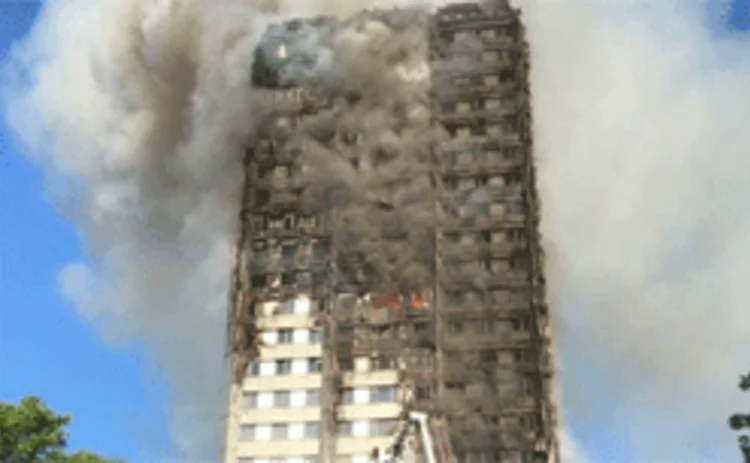
Analysis: Liability war rages over Grenfell-style cladding replacement claims

Need to know
- 301 buildings have Grenfell-type cladding
- Insurers may stop covering the risk
- Market is evaluating exposure to high-rise risk
- Focused has to be on client contact and understanding the risk
- Hackitt Review found current regulation “not fit for purpose”
- New Castle Quay development puts over 1000 homes at threat
A battle is raging over who is liable for costs to replace cladding on high-rise residential buildings across the country
In the weeks following the Grenfell Tower fire, which claimed 71 lives, defective or flammable cladding along with various other fire safety defects were identified by fire officials in multiple high-rise residential and commercial buildings across the country.
Government estimates suggest that 301 buildings over 18 metres tall have Grenfell-type cladding, of which 130 are in the private sector and 13 are hospitals or schools. Of the public buildings, only seven have had their cladding replaced so far.
Nova House
Nova House in Slough, a complex of 68 privately owned apartments has been deemed by building inspectors to have flammable cladding and substandard internal fire safety.
The six-storey building, built as an office block in the 1980s but converted into apartments in 2015, failed two separate fire inspections between June and August 2017.
Works to replace the cladding are estimated to be around £4m. In December, leaseholders were billed £22,000 each for the re-cladding works. The leaseholders argue that the freeholder rather than the leaseholders should pay.
The building is insured under a new home inherent defects insurance policy issued by BLP Insurance and underwritten by Allianz Global Corporate Specialty.
In November, building manager Ringley wrote to leaseholders on behalf of freeholders Ground Rent Estates 5 LTD, calling on leaseholders to take part in a collective insurance claim against BLP.
In a letter to a Nova house resident and seen by Post, BLP said as there was no evidence of structural damage to the building or breach of building regulations at the time of construction, the cost of replacing the cladding would not fall under the terms of the policy.
In the case of Nova House, it is likely that the bill will fall to the taxpayers, with Slough Borough Council agreeing to take over freehold of the property and pay for the works.
In another letter to residents from legal firm Clyde & Co, written on behalf of BLP, the firm acknowledged that while the situation is difficult for residents, the lack of structural damage to the building means the claim falls outside of the terms of the insurance policy.
“The joint inspection of the fire service; and fire consultant deemed it safe for the residents to remain in occupation, which was also influenced by the fact that the building is not high rise and there are various other fire safety measures in place in contrast to Grenfell,” the letter said.
“In the absence of actual or imminent damage, a claim for a structural defect in the context of the cladding issues would only otherwise be triggered under the BLP policy in the event that it can be shown that the cladding was installed in breach of the building regulations, which applied at the time of the conversion of the building.”
A spokesperson for BLP told Post: “This matter is currently being dealt with by solicitors and the policy coverage position is still under investigation. As such it is not appropriate for us to comment at the present time.”
Nova House is one of several disputes now raging across the country where multiple privately owned apartment blocks have been found to be clad in similar flammable panels to those which spread the fatal fire at Grenfell tower.
Buildings at risk
301 Buildings have failed Building Research Establishment test
- 158 Social residential buildings
- 130 Private residential buildings
- 13 Public sector buildings
63 Local authorities with at least one failed building
38 Local authorities contain at least one failed social housing building
Source: Building Safety Programme, Ministry of Housing, Communities and Local Government
Hackitt Review
Under the current framework, fire safety falls under a number of different areas including the Building Regulations 2010 and the Regulatory Reform Order 2005.
The Grenfell Tower incident highlights that construction and refurbishment methods and materials have changed significantly in the last decade and as such the government launched an Independent Review on Building Regulations and Fire Safety, led by Dame Judith Hackitt.
The Association of British Insurers has expressed concern about fire safety on construction projects, calling for greater clarity on the roles and responsibilities for all those involved and warned ministers about the dangers of flammable cladding prior to Grenfell.
The ABI submitted evidence and described the Hackitt review as “long overdue,” arguing that action is required by the government to update 11-year-old building regulations.
ABI director of general insurance policy, James Dalton, said: “The ABI has been calling for changes to buildings regulations since 2009 that would improve fire safety and it is terribly sad it took such a tragic event to bring about change.
“This review marks a seminal opportunity to recommend substantial change that will fundamentally improve fire safety in England’s buildings, but also, as a consequence, make these buildings more commercially attractive risks to insurers, increasing competitiveness and benefiting customers through an associated effect on premiums.”
The interim report of the Hackitt Review found the current system is “not fit for purpose” and called for an end to cost cutting on materials. The report argued that a culture change is required with the construction industry taking greater responsibility for what is built.
Dame Judith Hackitt said: “The regulatory system for safely designing, constructing and managing buildings is not fit for purpose. The current system is highly complex and there is confusion about the roles and responsibilities at each stage. In many areas there is a lack of competence and accreditation.
“While this does not mean all buildings are unsafe, it does mean we need to build a more effective system for the future. That is why I am calling for the construction industry, building owners, regulators and government to come together to identify how to overcome these shortcomings together.”
Commenting on the findings of the Hackitt review, Mark Shepherd, head of property at the ABI, said he welcomed the review findings and agreed with the call for greater collaboration.
“More detailed work is required in the next phase on the provision of sprinklers for high risk buildings, limiting the use of combustible materials in construction and developing more robust testing regimes to ensure improved fire safety standards are adhered to,” Shepard said.
Despite the findings, multiple blocks across the UK are still left with unsafe cladding and residents left in limbo as to who is liable to pay the costs.
Grenfell fire
- Grenfell Tower is Protector Forsikring’s largest claim to date
- £50m: estimated cost of claims Protector expects from Grenfell Tower
- £2.5m: Protector’s exposure
- Protector’s combined ratio tops 113.9% in 2017 as a result
Source: Annual Report 2017, Protector Forsikring
New Capital Quay
Back in the capital, the National House-Building Council, the largest warranty insurance provider for new homes in the UK, is facing multiple legal claims to recover the cost of removing cladding from New Capital Quay in Greenwich.
The development has cladding that has reportedly failed fire safety tests. Built in 2014 by British house building giant Galliard, New Capital Quay has nearly 1000 apartments and is the largest site to face massive bills to remove Grenfell cladding.
It is understood Galliard Homes, which owns the freehold, believes it has no responsibility to pay for its replacement. The company did respond to comment.
Costs to replace the cladding are estimated between £20m and £40m, The Guardian reported. Post calculates that, should owners be asked to pay, the costs could amount to £20,000 to £40,000 per flat.
Galliard has entered into negotiation with NHBC but no legal claim has yet been filed.
The dispute centres on the issue of who pays for cladding that was certified as compliant with building regulations at the time of installation but, since Grenfell, has been deemed to have failed fire safety rules.
A spokesperson from NHBC told Post: “We understand that the situation at New Capital Quay is very concerning for residents and we are committed to making an assessment of their claim as swiftly as possible once we have the necessary information.
“We have asked the managing agent PMML, which is legally responsible for the on-going safety of New Capital Homes, to provide evidence that the buildings did not comply with the building regulations in force at the time, annual fire risk assessments and maintenance records so that we can assess the claim.
“Since PMML has failed to provide this information and has not responded to our offers to assist, we have now stepped in to commission an independent expert to help us progress the claim as swiftly as possible for residents. Any court claim would be premature until the claim under the warranty has been assessed.”
Hackitt review
Six areas for change:
- 1 Regulation and guidance must be risk-based, proportionate and unambiguous
- 2 Sector roles and responsibilities need clarification
- 3 Improving levels of industry competence
- 4 Improving compliance and enforcement of regulations
- 5 Creating a clear, quick and effective forum residents’ concerns
- 6 Improve testing, marketing and control of construction materials
Source: Independent Review of Building Regulations and Fire Safety: Interim Report, Dame Judith Hackitt
Lessons learnt
The financial costs of claims related to flammable cladding are already well known to one insurer. Protector Forsikring, the Norwegian company responsible for insuring the Grenfell Tower, saw property and liability claims of £50m as a result of the fire.
Reinsurers will bear the majority of the claims costs but that didn’t stop the blaze pushing the insurer into a financial loss at the year-end 2016 with a combined operating ratio of 143.6%.
Protector Forsikring said losses from the fire would not hamper its growth plans in the UK but had resulted in a rethink as to how the insurer covers high-rise buildings with similar cladding issues.
Henrik Wold Høye, director of commercial and public lines at Protector Forsikring, said: “We have not changed premiums for individual tall buildings with flammable cladding panels. We have not changed our wordings and we have no exclusions or partial exclusions for claims related to cladding used on tall buildings where it does not comply with building regulations.
“We have not adjusted any prices as a consequence of buildings with flammable cladding, but we have experienced lower risk appetite in the market, for property owners that manage buildings with cladding.”
Høye said Protector has reviewed and updated its underwriting evaluations and approach related to tower blocks and tall buildings in general – both for new sales and renewals.
“For our clients with tower blocks, we are providing bespoke risk management to help evaluate a client’s risk and where best to target preventive actions,” he said.
“The insurance sector is in the middle of a learning process following the Grenfell fire. At Protector, we have had a thorough review of our underwriting and risk evaluation process. In relation to Royal Borough of Kensington and Chelsea, our conclusion is that the risk would have been written again today, which is proven in our renewal of the client.”
Høye added: “We have been reminded of the very large loss potential arising from tower blocks and similar properties, and the importance of focused risk management of these properties. From our first-hand experience, clients and councils have taken this very seriously and immediately completed remedial actions and preventative measures to make sure that such a tragedy will not be a repeat occurrence.”
Pricing change
Unlike Protector, Douglas Barnett, head of customer risk management at Axa UK, said some insurers are being forced to adjust prices or policy wordings to mitigate their risk exposure to buildings with flammable cladding panels.
“There may be instances where due to the type of panels being used we may not offer cover or the same capacity or require the insured to undertake a programme of replacement but this will be considered on a case-by-case basis,” Barnett said.
“We have been aware of the issues of using combustible materials within large properties and we have underwritten and priced for them accordingly.
Barnett added: “What Grenfell has done is highlight the extent of this issue which means that we will be more focused on fully understanding the risk which may influence the underwriting terms we apply and potential risk management actions.”
No changes
Neil Clutterbuck, chief underwriting officer at Allianz, confirmed the insurer has not changed policy wordings or increased premiums.
“Allianz continues to underwrite risks appropriately according to the exposure presented and have maintained a consistent underwriting approach,” he said.
“What became apparent following events at Grenfell was that a number of customers were not aware that the buildings they owned or occupied contained combustible materials and cladding.
“Buildings constructed with combustible materials are a higher risk than those with no combustible materials and, therefore, should pay more premium.”
Clutterbuck said that insurers might wish to limit their exposures to such risks as a result, adding the risk may need to be shared across carriers to make the risks insurable and financially viable.
“It is likely that some insurers may choose to restrict the exposure they are willing to put down on risks with combustible cladding, compared to similar risks with no combustible materials,” he said.
“It is possible that these risks may need to be shared by multiple insurers by co-insurance or reinsurance solutions.”
Only users who have a paid subscription or are part of a corporate subscription are able to print or copy content.
To access these options, along with all other subscription benefits, please contact info@postonline.co.uk or view our subscription options here: https://subscriptions.postonline.co.uk/subscribe
You are currently unable to print this content. Please contact info@postonline.co.uk to find out more.
You are currently unable to copy this content. Please contact info@postonline.co.uk to find out more.
Copyright Infopro Digital Limited. All rights reserved.
As outlined in our terms and conditions, https://www.infopro-digital.com/terms-and-conditions/subscriptions/ (point 2.4), printing is limited to a single copy.
If you would like to purchase additional rights please email info@postonline.co.uk
Copyright Infopro Digital Limited. All rights reserved.
You may share this content using our article tools. As outlined in our terms and conditions, https://www.infopro-digital.com/terms-and-conditions/subscriptions/ (clause 2.4), an Authorised User may only make one copy of the materials for their own personal use. You must also comply with the restrictions in clause 2.5.
If you would like to purchase additional rights please email info@postonline.co.uk








